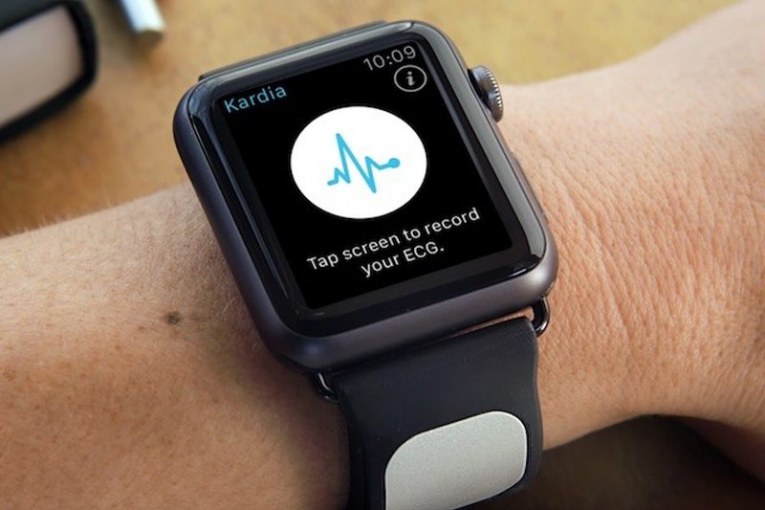
Check out some of the latest wearable gadgets designed to improve health and wellness while keeping convenience in mind:
AliveCor
In 2011, inventor Dr. David Albert founded AliveCor, the company behind the device that allows people to monitor their heart activity anytime, anywhere. While doctor’s visits using similar technology can become costly, the FDA-approved, over-the-counter solution for just $99 consists of two pads on which users just place two fingers.
Using the Kardia app compatible with any smartphone, it instantly picks up heart activity, letting the wearer know if their heart’s cardiac rhythms are normal. Albert said this information can then be relayed to their caregiver – be they a physician or nurse.
“We look at the power of the smartphone and artificial intelligence and cloud computing that will all combine to really enable people to gage and in their own care, and empower them to be responsible,” he said. “And that’s critical if we’re going to deal with this major issue. Heart disease remains the number one killer – causing more deaths than all forms of cancers combined.”
He described the process as democratic and self-controlled in fashion, avoiding the traditional barriers that are put up in medicine – making it more personalized and cost-effective.
In the six years since it’s launched, AliveCor has been picked up by physicians at some of the top medical centers in the country, like the Mayo Clinic, Cleveland Clinic and Massachusetts General, he said.
He said that while most users are people with heart problems, the number of people of all ages who are becoming heart-aware is proliferating.
“The reality is that a huge majority of heart patients don’t manifest heart disease until they get to past their fifth and sixth decades,” he said.
AliveCor and its corresponding Kardia app are just one of many ushering in a new era of technologies that help people get and stay healthy.
Devices like FitBits and Garmin Vívofits help people track their physical activity throughout the day, workouts, quality and quantity of sleep and even their water intake.
FitBit
FitBits track steps and calories while boasting features like a 3-axis accelerometer. The accelerometer is useful because it processes aspects of movement, like frequency, intensity, number of steps taken, distance and calories burned – and converts those into digital measurements, according to the site.
Its heart rate monitor feature comes in handy when users engage in more rigorous activity.
Teresita Alejo, 34, said she particularly loves the sleep feature on her FitBit Blaze. She said the Blaze goes so far as to track quality of sleep – including specific breakdowns of REM (deep) sleep versus light sleep and how much she moved throughout the night.
“It tells you how many hours you sleep,” she said. “And I just love that feature because I always try to sleep eight hours a day. So, the next morning when I wake up and see that I slept five or six, I know that the next day I need to go to sleep a bit earlier.”
And when it comes to her workouts, she said it keeps her not only motivated, but consistent. If she didn’t work out as hard as she needed to one day, she’ll try harder with her next workout, she said.
“Before when I didn’t have a Fitbit, I was all over the place, not seeing the results I wanted — versus now that I have the option to monitor my sleep & other cool features I can definitely see the results that I’ve been working hard for,” she wrote in an email.
Garmin Vívofit
Vívofit learns users’ current activity level and assigns a daily goal, according to the Garmin Vívofit site. As users meet those goals, the Vívofit adjusts goals for the next day so users can continue progress. It tracks progress around the clock, seven days a week and stays on for more than a year without the battery dying. It is also water-resistant, which always comes in handy.
For those who are desk-bound throughout the day and concerned about the adverse effects of inactivity on their health, Vívofit displays a red “move bar” which comes on after one hour of being sedentary, prompting users to get up and get the blood pumping. A few minutes of resuming activity resets the bar, according to the site.
Josh Hyde, 28, said he’s had his Garmin Vívofit for about a year. A former college athlete, he said he particularly loves his Garmin Vívofit when he’s working out and on the golf course. He utilizes its wristband and heart strap features.
“I’m very active about heart rate recovery status, so it’s very accurate when I wear my chest strap,” he said.
PIP
PIP is a device that’s used to actively combat stress and keep it in check during an acute stress response. Resembling an egg cut in half, it works by allowing users to place one finger on a pad while playing a game using one of its four corresponding smartphone apps or games, according to the KickStarter site, a corporation for creative projects. The visuals seen on their phone screens are then translated to visuals and audio that allow users to see fluctuating stress levels.
When stressed, the body’s fight-or-flight response oftentimes causes us to secrete sweat. PIP uses this sweat response to conduct an electrical current from fingertips to device and pick up on stress levels through these indicators, according to Kickstarter.
The body’s fight-or-flight response system is characterized by the activation of the sympathetic nervous system and the release of hormones like adrenaline, which all increase heart rate and blood pressure, according to VeryWell.com.
Muse Headband
After keeping stress levels in check, users can then meditate effectively using the Muse Headband.
When placed around the forehead, the headband guides meditation through various weather sounds that reflect the state of the brain, according to the Muse Headband site. It then gives feedback of where the mind goes during meditation by varying the sounds of the wind. For example, calm and gentle winds signify a relaxed state, while winds pick up when the mind is more active.
Meditation has been proven to be effective in reducing symptoms associated with stress, depression and anxiety, according to the site.
By Kristina Orrego




